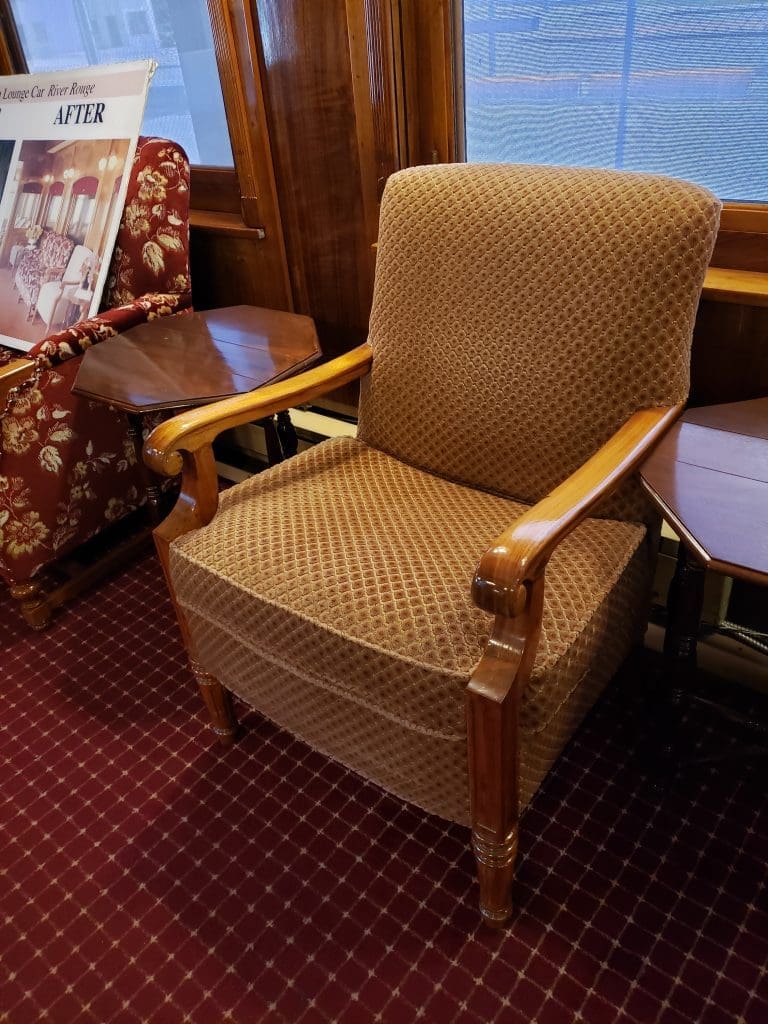
Take a Seat: Chair Design and History
By Eileen Kosasih and Emily Russell
You might not think too much about what you sit on. A chair’s design and function can tell us a lot about the time and place it was made in. What movements in history led to your chair looking and functioning the way it does?
Lets examine three chairs at the museum.
Chair #1: Armchair in the River Rouge

This armchair has several unusual features for a lounging chair. It has open (aka pierced), full-length arms atop supports that extend into its front legs. Normally, early 20th century armchairs are plush and fully covered. They usually have manchettes, or arm cushions. This chair’s arms are quite long and close to the seat. Picture yourself trying to relax your arms on this chair. Not so easy.
This chair was likely designed and manufactured by the same guy (we can safely assume the maker was male). He likely came from vernacular (local design language) tradition. The clumsy scrolls might trickle down from the Louis. The maker was directly or indirectly influenced by the Aesthetic movement and Arts and Crafts movements, both British movements that focused on fine craftsmanship in the domestic realm. Both movements were responses to the takeover of mass production and machinery. The two movements massively pervaded in Canada, not just in furniture design, but in literature, architecture, prints, and other crafts. The Arts and Crafts produced works known for quality, comfort, detailed decoration, unique character, quality materials, and references to literature.
This chair looks like a regional version of a chair form popular from around 1880 to 1920 in Britain and North America. One possible aesthetic influence is the work of H. W. Batley. Batley was a designer part of the Aesthetic movement in Britain. His book of furniture designs made it to North America and was even on display at an international design fair.

Chair #2: Tub chair in the River Rouge

This is one of my favourite chairs in the museum. It looks pretty comfy, sleek, and balanced. Unfortunately, we are not allowed to test that out.
This type of chair, with the boldly round back that smoothly slopes into its arm, is called a tub chair. This particular tub chair shares visual vocabulary with French Empire, George III, early Victorian, Edwardian, Regency, and other Georgian tub chairs. The form was very popular in the mid 19th century and has never really gone out of style.
Again, we see unusual pierced (open) arms. Its legs are chunky, reeded baluster forms.
A PAIR OF WILLIAM IV MAHOGANY TUB CHAIRS, (christies.com)
AN EARLY VICTORIAN ROSEWOOD TUB CHAIR (christies.com)
Chair #3: Bench in Museum Lobby

The bench is an example of beautiful design and excellent craftsmanship.
This design is reminiscent of the American Shaker style that was popular in the nineteenth century. The design is elegant and unassuming. The bench features a sleek spindle design with even proportions, giving it a more modern feel.
I suggest reading Excavating Utopia: Why Archaeologists Should Study “Ideal” Communities of the Nineteenth Century by Sarah Tarlow to learn more about how modernity influenced Western values, styles, and ideologies in the nineteenth century.